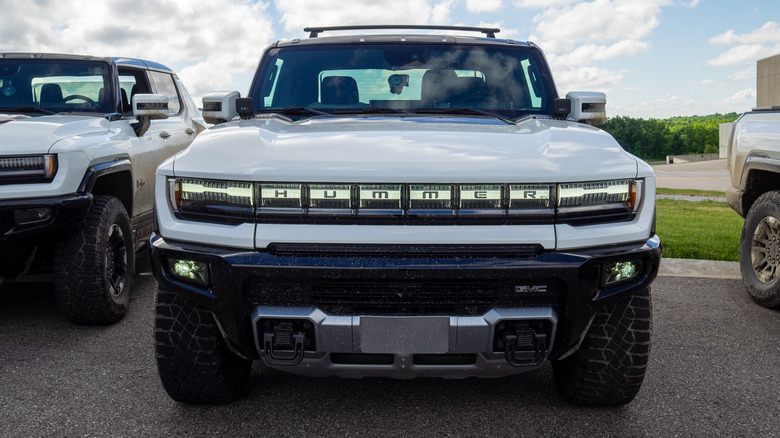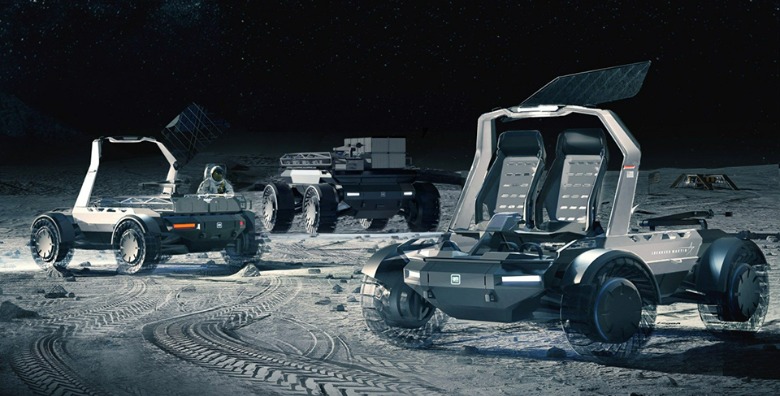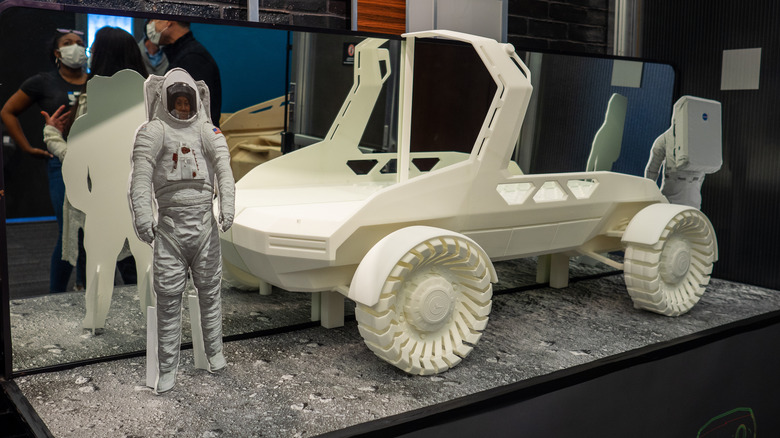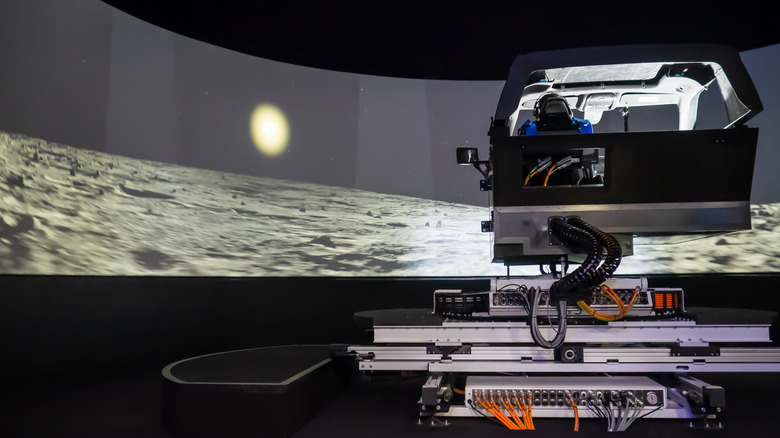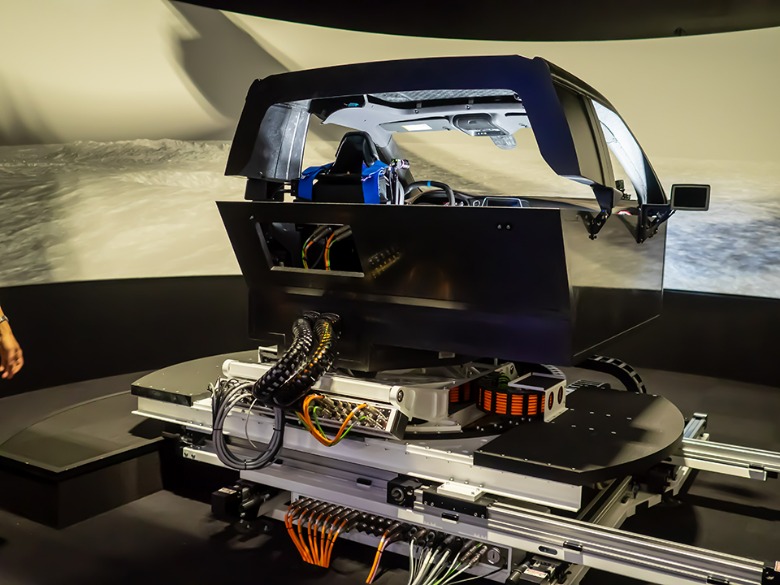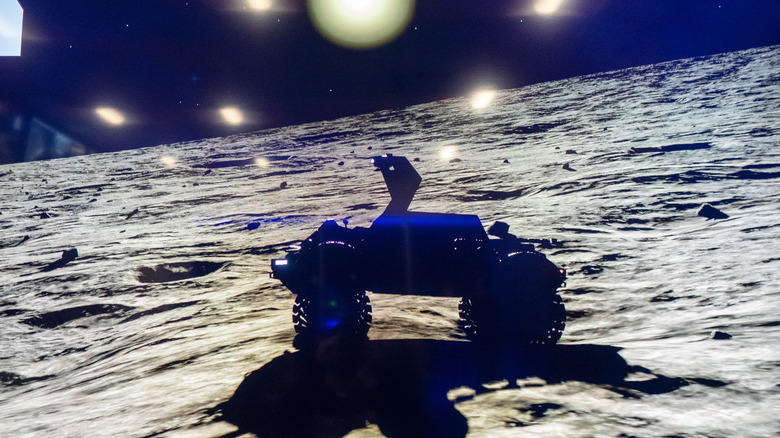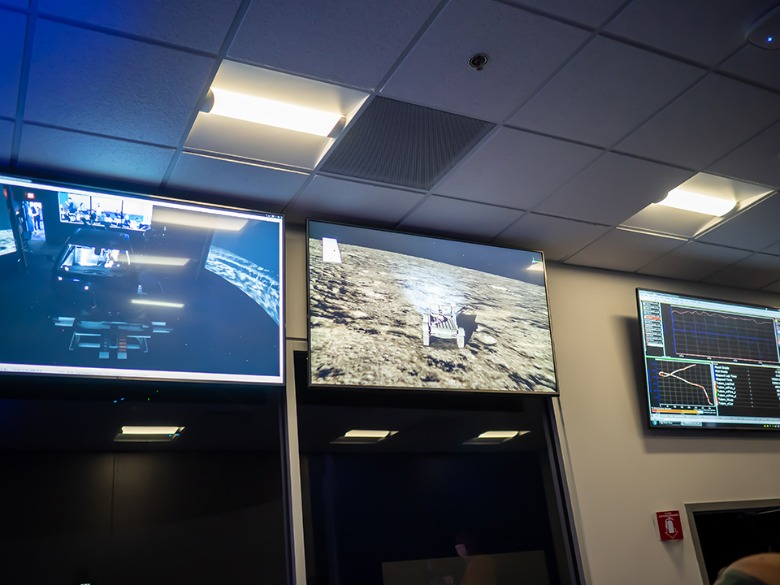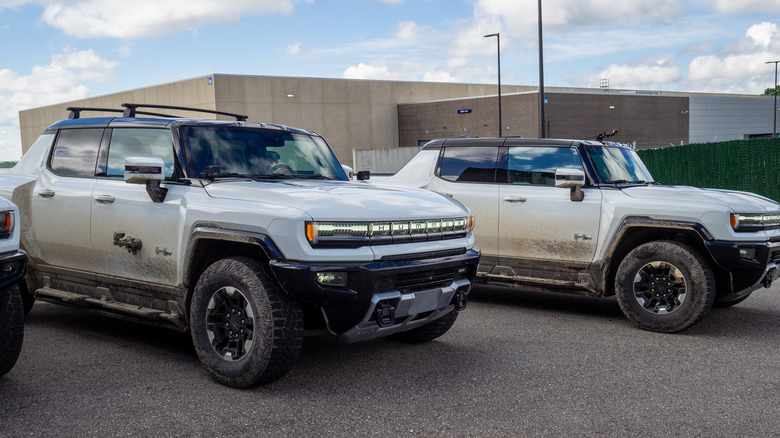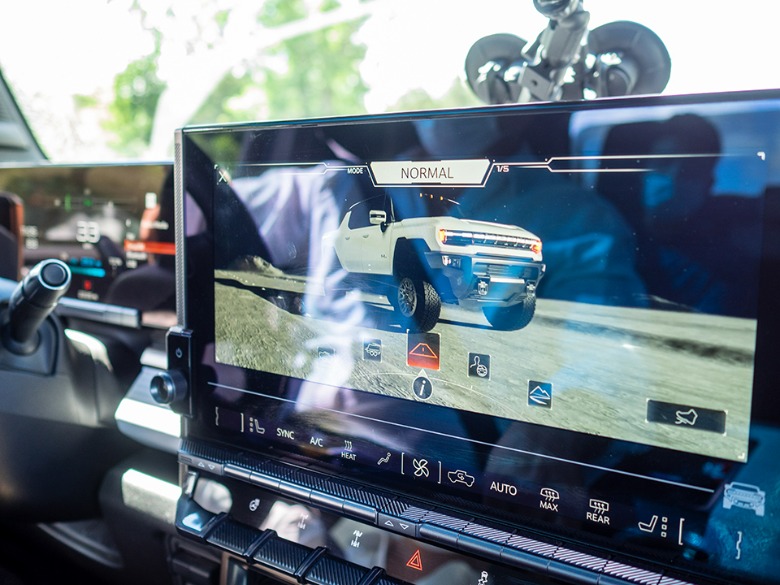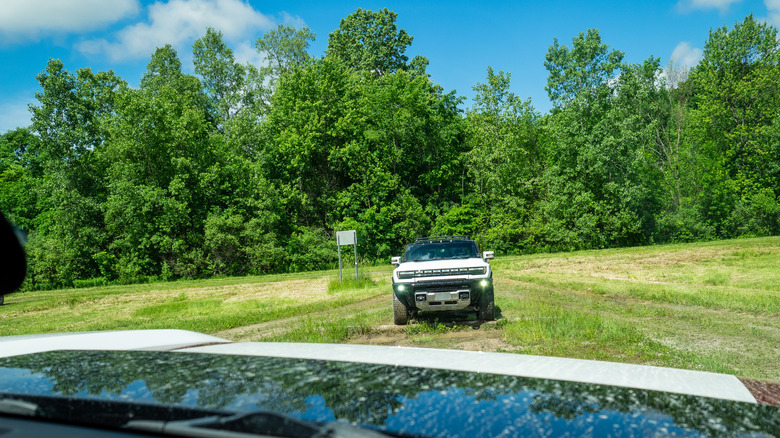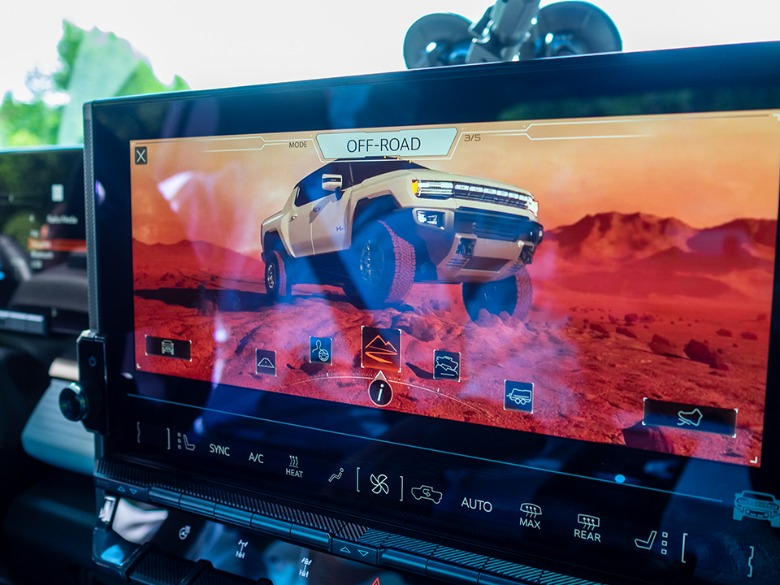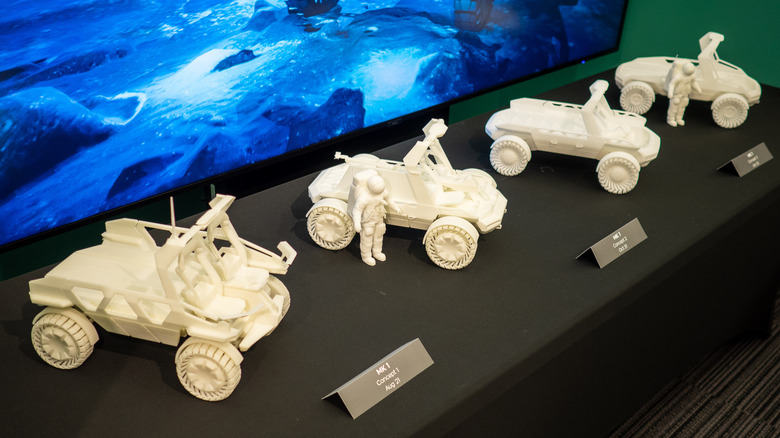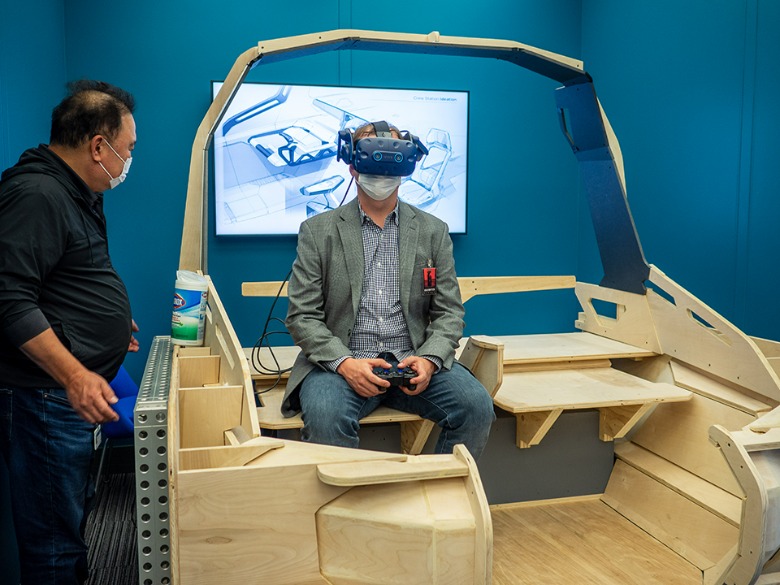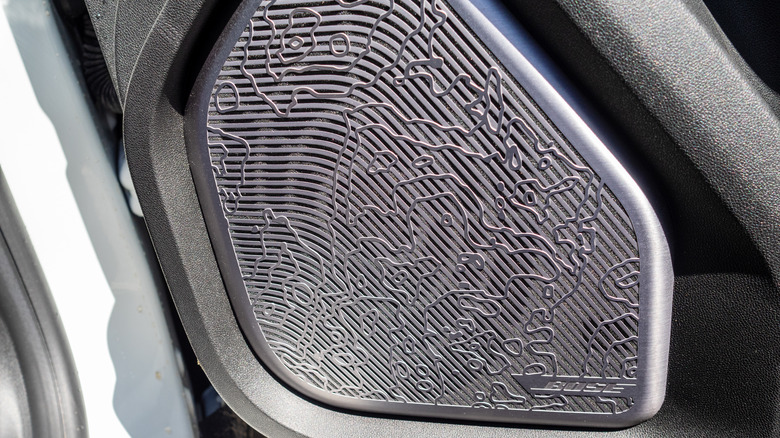Moon Off-Roading In The Wild GM Electric Car That Makes Hummer EV Look Normal
Over 50 years ago, three brave astronauts — Neil Armstrong, Edwin "Buzz" Aldrin and Michael Collins — took to the heavens above to achieve the impossible: setting foot upon the Moon. That feat of humanity was part of NASA's Apollo program, born in U.S. President Dwight D. Eisenhower's administration before his successor, the late President John F. Kennedy, took hold of the flame to make it the nation's goal to land a human on the Moon by the end of the 1960s.
Alas, all good things must come to an end, but what a way this one did. The final three Apollo missions (15, 16 and 17) in 1971 and 1972 introduced motoring to the Moon, in the form of the Lunar Roving Vehicle. Three LRVs — each built by General Motors in a partnership with Boeing — found their way beyond the Earth, traversing the lunar landscape at a pace of up to 8 mph (though the Apollo 17 LRV reached just over 11 mph) with electric power moving each of the 32-inch wire tires.
In a few years' time, humanity will return to the Moon through NASA's Artemis program. The program's mission is to land astronauts on the Moon's South Pole by 2025. NASA won't be alone for the ride, either, especially when it comes to driving upon the regolith and rocks near the landing site. Once again, GM is working on a new Lunar Terrain Vehicle, this time with Lockheed Martin. And this LTV has quite the foundation to build upon, via the GMC Hummer EV.
Getting there from here
"One of the other firsts that we've done here at General Motors is we put the first lunar rover on the Moon," said Brent Deep, chief developmental engineer for the joint program between GM and Lockheed Martin. "We're proud to be able to supply the first rover [...] It's very humbling for me to be a part of [the rover's history], and to look at what [the Lunar Roving Vehicle engineers] did back in the Sixties to develop that rover for a really unknown environment."
Fast-forward to today, GM and Lockheed Martin are gunning for the big contract with NASA to build the Lunar Terrain Vehicle. Unlike the partnership between the General and Boeing, which was more to determine if driving on the Moon was even possible, the new partnership takes the knowledge gained from the LRV as part of the foundation in building a ride for the long-term. After all, the main mission of the Artemis program is to establish a base of operations on the Moon's South Pole, the first step in the push to colonization of the Solar System and beyond, with Mars as the next step.
Of course, it's going to take a lot to get there from here. Luckily for GM and Lockheed Martin, the key piece of the puzzle is already being drip-fed into showrooms. But we're getting ahead of ourselves here; we've got a simulator to check out first.
This isn't your iRacing rig
Following the morning's presentation at the Milford Proving Grounds in Milford, Michigan, I headed straight into the simulation room to virtually drive upon the Moon's South Pole on the multi-million-dollar "Driver in the Loop" simulator from U.K.-based Ansible. Though other versions of the sim are usually used for working on Chevrolet's racing efforts in NASCAR and IMSA (which explains the C8 Corvette steering wheel), this rig is helping to develop the Lunar Terrain Vehicle before the real deal hits the testing grounds (or, later on, the regolith).
This certainly was a different experience compared to my usual sim experience. When not in the broadcast booth with the Podium eSports crew to keep an ear open for potential wrecks or exciting battles for position, I'm the one on the track in iRacing involved in potential wrecks and/or exciting battles for position. With an Xbox One controller and a single 27-inch flat-panel monitor.
Though some iRacing rigs can really reach for the stars to provide the best simulation possible on the track, they could never reach the level this ride does. And what a ride, too. With a warning not to go into the virtual craters of the Lunar South Pole, lest I lose a bunch of my allotted five minutes being reset, I carefully set out on my short drive on the Moon. The virtual LTV floated (almost literally at points) along the vague path I followed around one of the craters, leaping off a good-sized rock after my front wheel caught it underneath. Though no monoliths were to be found along the way, I pointed the LTV towards the Sun in a partial eclipse, singing the chorus of "Black Hole Sun" by Soundgarden all the way to the end of my drive.
Ground Control to Major Tom
While entertaining the virtual ground control with the sounds of Seattle, the crew on the other side of the glass kept us from driving off the map (a 1-sq.-km. patch of the Moon's South Pole taken from actual mapping data), logging more data from my drive and those of my group. The Driver in the Loop (or DiL) lab was designed for vehicle performance simulation, including that of the ultimate performer GM and Lockheed Martin hope to get the green light from NASA to put into production.
To build this particular DiL, the staff reached out to NASCAR, IMSA and IndyCar teams to learn what could be done as far as improving learning for vehicle performance goes. The new DiL played a key part in the development of the C8 Corvette and the Hummer EV before tackling its greatest task to date with the Lunar Terrain Vehicle program. Both earth-bound vehicles provided key insights to the lab staff as far as how ECUs could better do their jobs in managing various systems on the road and track, and how EVs could handle the roughest environments, each contributing to the LTVs development on Earth in a virtual environment.
From nothing to a monster (EV)
Following the virtual drive on the Moon's South Pole, it was time to come back to the reality of Earth with some time in one of the most unreal beasts of the burgeoning electric vehicle scene, the 2021 GMC Hummer EV. Classified as a medium-duty truck at nearly 10,000 pounds, the four-door off-roader charges off the line to 60 mph like a linebacker in three seconds. All this is possible thanks to three electric motors delivering a combined 1,000 horsepower and 14,500 lb.-ft. of torque to the 35-inch Goodyears at each corner through a single-speed direct-drive transmission.
What does this have to do with GM and Lockheed Martin's mission with the Artemis Lunar Terrain Vehicle, though? The answer's been staring at us since the Hummer EV's introduction.
"The reason for showing the Hummer is to show you this tight integration to our virtual tools that's really important for [the lunar rover]," said Deep. "The virtual tools are the best thing you're ever gonna have here on Earth."
Much like the ongoing development of the Lunar Terrain Vehicle for the Artemis program, the GMC Hummer EV was developed and refined through tools like the Driver in the Loop simulator rig. As Deep explained, the Hummer EV program was a clean slate back in 2019. Two years later, the Hummer EV Edition 1 debuted ready for the showroom (complete with some cheeky space Easter Eggs). All possible through GM's virtual tools, now aimed at returning humanity to the Moon.
As on Earth, so in Heaven
Deep was the pilot of the Hummer EV I rode shotgun in during the morning ride through the Milford Proving Grounds, where he talked about not only what it took to bring the beefy GMC into existence, but how the tools used in development and the data gathered related to the Lunar Terrain Vehicle program. One of the most important parts is torque vectoring: being able to shift around torque where and as needed when traversing the rockiest and slipperiest terrains in both the Hummer EV and upcoming Hummer EV SUV. Deep mentioned it was difficult to get all three electric motors to talk to each other to accomplish this at first, but through work in the simulator, not only can the behemoth EV tackle the great outdoors with ease, but the resulting data could also be used as a starting point for climbing over lunar rocks and managing the regolith beneath the wheels.
Of course, just experiencing the GMC Hummer EV do it all was as fun as learning how the giant will contribute to humanity's next great achievement. From donuts on a patch of dirt to a launch down the track so hard I felt the power in my stomach, the electric leviathan proved capable in everything it did on the proving grounds. Alas, it'll only get to drive on the Moon or Mars via the 12.3-inch center-stack touchscreen, as well as in spirit via the LTV.
Ad astra per aspera
After experiencing how the Hummer EV could storm around the Milford Proving Grounds, it was time for a trip to the General Motors Design Studio in Warren to see not only how far GM and Lockheed Martin have come thus far in their pursuit of the NASA contract, but to learn more about the tools used to get there, and what the current status of the project is.
Alas, said status cannot be shown or talked about, as that remains a secret until the partners are ready to reveal the next step to the public. What can be talked about and shown, though, is the evolution of the program, such as the above photo of the various LTV concepts, all 3D printed. As explained by GM Industrial Design Director Jeff Nield, the program's design team operates "much like a startup," working quickly to bring potential ideas to life through tools like rapid prototyping via 3D printing and using virtual reality on a wood mockup of the LTV's cockpit to get a better sense of operating the lunar vehicle.
The design team is also involved in the Ultium EV ecosystem, which will power the LTV if and when it goes up to the Moon, as well as autonomous system engineering; the LTV is meant to be a Level 5 ride, doing its work without humans for 99% of the calendar year. And of course, since this will be driven by humans on occasion, the design team reached out to the original astronauts from the Apollo program to get direction on where to go with the new rover program.
The future is not written
It's been decades since the last astronauts left their lunar rover on the Moon to return home to Earth. In the time since, several space missions have gone up and come down, with more on the way. Yet humanity hasn't explored much further beyond the space above the Pale Blue Dot, preferring various rovers and probes to handle exploration.
For us to grow as a species, we must return to the Moon in a more permanent capacity, and for GM and Lockheed Martin that means providing a vehicle for exploring and building upon the lunar surface. This time around, though, it's one with ties to the wildest machines promising to upend transportation on Earth, like the GMC Hummer EV.
